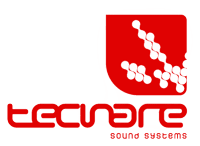Explore the World of Sound
Sound Distribution to Enhance Listener Experience in Different Spaces
Proper sound distribution is essential for ensuring an optimal listening experience in various environments, whether in concerts, theaters, conferences, or nightclubs. The choice of sound reinforcement systems, their placement, and calibration directly impact intelligibility, coverage, and sound uniformity in a venue.
The goal is to achieve homogeneous sound distribution, avoiding dead spots, areas with excessive SPL, and issues like phase cancellations and uncontrolled reverberation. In this article, we will explore the best strategies for optimizing sound distribution in different spaces, using examples from Tecnare systems, such as CLA208, CLA21PLUS, and CLA312 line arrays, IBZA Series full-range boxes, and SW218V and SW218EB subwoofers.
Sound Distribution to Enhance Listener Experience
2. Principles of Sound Distribution
To ensure efficient sound coverage, the following aspects must be considered:
✅ Uniform coverage: Distribute sound pressure evenly throughout the venue.
✅ Intelligibility: Ensure that sound content is understandable at all listening points.
✅ Reflection and reverberation control: Minimize the impact of reflective surfaces that could affect sound clarity.
✅ Phase coherence: Avoid destructive interference and temporal alignment issues between sound sources.
📌 Practical Example: In a theater with CLA208, main arrays can be installed facing the audience, with IBZA Series frontfill reinforcement to ensure coverage of the first rows without excessive pressure from the main PA.
3. Configuration According to the Type of Space
Sound distribution varies depending on the type of venue and the purpose of the event. Below are optimal configurations for different environments:
3.1. Open-Air Spaces and Outdoor Concerts
Outdoor concerts present the challenge of projecting sound over large distances without excessive energy loss.
🔹 Use of line array systems
✔️ CLA21PLUS or CLA312 allow for vertical dispersion control and prevent pressure loss over distance.
✔️ The tilt of each array box should be calculated to achieve homogeneous coverage from the front rows to the back.
🔹 Use of delays for reinforcement
✔️ To prevent sound attenuation over long distances, delay towers with additional arrays or IBZA Series full-range boxes can be aligned in time with the main PA.
✔️ The latency is adjusted in the DP4896 processor to synchronize the sound of the delay towers with the main PA.
📌 Practical Example: In a festival with CLA312 as the main PA and IBZA12 as frontfill reinforcement, delay adjustments ensure that the audience at the back of the venue receives sound with the same coherence as the front rows.
3.2. Theaters and Auditoriums
In enclosed spaces with high reverberation, it’s crucial to control sound dispersion and improve intelligibility.
🔹 Use of directional systems
✔️ A well-configured CLA208 or CLA21PLUS array directs sound only toward the audience, avoiding reflections from walls and ceilings.
✔️ IBZA10 or IBZA12 frontfills can improve coverage in the first rows without increasing the pressure from the main PA.
🔹 Frequency and time control
✔️ Apply equalization in the DP4896 to reduce problematic frequencies that cause reverberation buildup.
✔️ Adjust phase alignment between the main PA and lateral or fill reinforcements to avoid wave cancellations.
📌 Practical Example: In an auditorium with CLA208 as the main PA and IBZA10 as frontfill, correct EQ and time alignment improve sound intelligibility without unnecessarily increasing SPL.
3.3. Clubs and Entertainment Venues
In nightclubs and bars, the priority is to maintain powerful and clear sound pressure without causing listening fatigue or excessive SPL in certain areas.
🔹 Sound source distribution
✔️ Instead of a single emission point, use multiple full-range speakers (IBZA15, IBZA12) distributed strategically.
✔️ SW218V or SW218EB subwoofers should be placed in a cardioid arrangement or in clusters to avoid low-frequency buildup in certain areas.
🔹 Directionality and SPL control
✔️ Equalization in the DP4896 allows limiting SPL in certain areas to prevent saturation.
✔️ Speakers should be directed towards the dance floor while minimizing sound leakage to other areas.
📌 Practical Example: In a nightclub with IBZA15 distributed on ceiling and walls and SW218EB in cardioid configuration, homogeneous coverage is achieved without excessive bass buildup in corners.
4. Tools for System Optimization
4.1. Use of Simulation Software
🔹 EASE Focus: Allows for the design of array distribution and sound coverage calculations before installation.
🔹 Smaart Live: Analyzes the frequency spectrum and system response in real time within the venue.
📌 Practical Example: Before installing a system with CLA21PLUS, simulate the dispersion of mid-high frequencies in EASE Focus and correct any deficiencies before setup.
4.2. Adjustment with Signal Processors
🔹 Tecnare DP4896:
✔️ Allows for advanced equalization and delay adjustment across different zones of the venue.
✔️ Controls phase alignment between subwoofers and tops to prevent frequency cancellations.
📌 Practical Example: In an auditorium with CLA208 and SW218V, use the DP4896 to adjust the time alignment between subs and tops, ensuring more coherent response at the listening point.
5. Conclusion
Achieving efficient sound distribution requires strategic design based on:
✅ Proper selection of sound systems based on the venue type.
✅ Optimal placement and orientation of speakers and subwoofers to avoid dead zones or areas with excessive SPL.
✅ Use of simulation software and signal processors for precise coverage adjustments and phase alignment.
With professional solutions like Tecnare CLA21PLUS, CLA312, IBZA Series, and DP4896 processors, it’s possible to optimize sound distribution in any type of space, ensuring a superior listening experience for all attendees.
Featured Articles
Explore Other Topics
Acoustic Science
Audio Technology
Sound Design
Music Production
Environmental Acoustics
Psychoacoustics
Audio Engineering
Sound History
Tecnare
Loudspeakers Series
E Series
IBZA Series
V Series
ALIS Series
Array Series
SW Series
KT Series
TANIT Series
CS Series
Amplifiers Series
Digital Processors
Accessories
